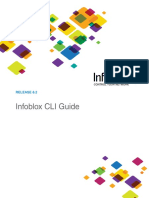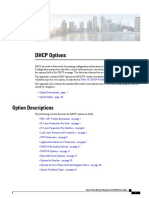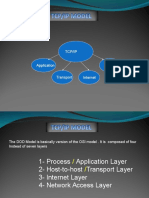0 ratings0% found this document useful (0 votes)
24 views10GbE MAC
10GbE MAC
Uploaded by
rhideThis document provides an overview of 10 Gigabit Ethernet including:
1) It discusses how 10 Gigabit Ethernet maintains backwards compatibility with previous Ethernet standards while introducing new features required for higher speeds such as the removal of half duplex and CSMA/CD.
2) It compares key parameters between 1 Base-5 Ethernet, 1 Gigabit Ethernet, and 10 Gigabit Ethernet and how they are maintained across the standards.
3) It outlines the objectives of the 10 Gigabit Ethernet standardization group and the layers of the OSI model that are defined in the 10 Gigabit Ethernet specification.
Copyright:
© All Rights Reserved
Available Formats
Download as PDF, TXT or read online from Scribd
10GbE MAC
10GbE MAC
Uploaded by
rhide0 ratings0% found this document useful (0 votes)
24 views22 pagesThis document provides an overview of 10 Gigabit Ethernet including:
1) It discusses how 10 Gigabit Ethernet maintains backwards compatibility with previous Ethernet standards while introducing new features required for higher speeds such as the removal of half duplex and CSMA/CD.
2) It compares key parameters between 1 Base-5 Ethernet, 1 Gigabit Ethernet, and 10 Gigabit Ethernet and how they are maintained across the standards.
3) It outlines the objectives of the 10 Gigabit Ethernet standardization group and the layers of the OSI model that are defined in the 10 Gigabit Ethernet specification.
Original Description:
10g
Original Title
10GbE_MAC
Copyright
© © All Rights Reserved
Available Formats
PDF, TXT or read online from Scribd
Share this document
Did you find this document useful?
Is this content inappropriate?
This document provides an overview of 10 Gigabit Ethernet including:
1) It discusses how 10 Gigabit Ethernet maintains backwards compatibility with previous Ethernet standards while introducing new features required for higher speeds such as the removal of half duplex and CSMA/CD.
2) It compares key parameters between 1 Base-5 Ethernet, 1 Gigabit Ethernet, and 10 Gigabit Ethernet and how they are maintained across the standards.
3) It outlines the objectives of the 10 Gigabit Ethernet standardization group and the layers of the OSI model that are defined in the 10 Gigabit Ethernet specification.
Copyright:
© All Rights Reserved
Available Formats
Download as PDF, TXT or read online from Scribd
Download as pdf or txt
0 ratings0% found this document useful (0 votes)
24 views22 pages10GbE MAC
10GbE MAC
Uploaded by
rhideThis document provides an overview of 10 Gigabit Ethernet including:
1) It discusses how 10 Gigabit Ethernet maintains backwards compatibility with previous Ethernet standards while introducing new features required for higher speeds such as the removal of half duplex and CSMA/CD.
2) It compares key parameters between 1 Base-5 Ethernet, 1 Gigabit Ethernet, and 10 Gigabit Ethernet and how they are maintained across the standards.
3) It outlines the objectives of the 10 Gigabit Ethernet standardization group and the layers of the OSI model that are defined in the 10 Gigabit Ethernet specification.
Copyright:
© All Rights Reserved
Available Formats
Download as PDF, TXT or read online from Scribd
Download as pdf or txt
You are on page 1of 22
10 Gigabit Ethernet
The New Frontier
Presentation by Rupert Dance
Introduction
! EthernetLegacy
! New Features
! Implementation
! Conclusion
The Legacy of 10 Gb Ethernet
! Frame size
– Minimum frame size 64 bytes
– Maximum untagged frame size 1518 bytes
! Half duplex
– Supported from 1 Mb through Gigabit
– No half duplex in 10 Gb Ethernet
! Full duplex - no CSMA/CD
– Simultaneous transmission and reception
– No carrier sense and no collision detection
– No frame extension and no frame bursting
Comparisons
Maintaining Backwards Compatibility
Parameters 1 Base-5 1 Gb/s 10 Gb/s
10 Mb/s
100 Mb/s
slotTime 512 bit times 4096 bit times not applicable
interFrameGap 96 bits 96 bits 96 bits
attemptLimit 16 16 not applicable
backoffLimit 10 10 not applicable
jamSize 32 bits 32 bits not applicable
maxUntaggedFrameSize 1518 octets 1518 octets 1518 octets
minFrameSize 512 bits (64 octets) 512 bits (64 octets) 512 bits (64 octets)
burstLimit not applicable 65 536 bits not applicable
ifsStretchRatio not applicable not applicable 104 bits
HSSG Objectives - Nov 1999
! Support a speed of 10.0 Gb/ s at the MAC/ PLS
service interface
! Define two families of PHYs:
– A LAN PHY, operating at a data rate of 10.0 Gb/ s
– A WAN PHY, operating at a data rate compatible with
the payload rate of OC- 192c/ SDH VC- 4-64c
! Define a mechanism to adapt the MAC/ PLS data
rate to the data rate of the WAN PHY
OSI Model – 10 Gigabit
LAN
LAYERS
OSI HIGHER LAYERS
REFERENCE
MODEL LLC - LOGICAL LINK CONTROL
LAYERS
MAC CONTROL (OPTIONAL) Clause 31
APPLICATION
MAC -- MEDIA ACCESS CONTROL Clause 4
PRESENTATION RECONCILIATION
XGMII (Optional) Clause 46
SESSION
XGXS (Opt)
TRANSPORT
XUAI (Optional) Clause 47
NETWORK
XGXS (Opt)
PCS Clause 48 & 49
DATA LINK
WIS Clause 50
PMA Clauses 48, 51, 53
PHYSICAL
PMD Clause 52 & 54
MDI
MEDIUM
MDI = Medium Dependent Interface WIS = WAN Interface Sublayer
PCS = Physical Coding Sublayer XAUI = 10 Gigabit Attachment Unit Interface
PMA = Physical Medium Attachment XGMII = 10 Gigabit Media Independent Interface
PMD = Physical Medium Dependent XGXS = XGMII Extender Sublayer
Rate Control
MAC - PHY
Rate Control Alternatives
! Fine granularity rate control
– Word- by- Word
! Packet granularity rate control
– Carrier Sense based
– Busy Idle
– Self pacing in the MAC
Rate Control Alternatives
Word-by- Word
! Adds a “hold” signal on the XGMII from the PHY
to the MAC
– MAC stops transmission for one clock cycle
– The MAC inserts “nulls” into the data stream
! Issues
– Interrupts the flow of data through pipeline stages
– Makes buffer pre- fetching difficult
– Tricky timing
– MAC is no longer a scaled version
Rate Control Alternatives
Busy Idle
! PHY sends “Busy Idle” to MAC during IPG
– MAC pauses transmission at frame boundary
! PHY sends “Normal Idle” to MAC during IPG
– MAC resumes transmission
! Need a ~256 byte FIFO in WAN PHY Tx path
! Issues
– Too much overhead
– PHY has to monitor FIFO and send blocking signal
– MAC has to monitor signal and block transmission
Rate Control Alternatives
MAC Self-Pacing
! MAC “knows” the PHY is slower and by how much
! MAC adapts its average data rate by extending the IPG
after each frame transmission
! MAC never exceeds the average data rate in the PHY, with
packet granularity
! IPG extension is “dynamic” --- depends on the size of the
last transmitted frame
! PHY is only required to sustain the transmission of one
maximum size packet
! Requires a rate adaptation FIFO in the PHY of ~64 bytes
(plus framer overhead)
MAC Self-Pacing
Pascal Variables - 4.2.7.2
! ifsStretchMode: Boolean
– Indicates the desired mode of operation,
– Value does not change between invocations of the Initialize procedure
! ifsStretchCount: 0..(ifsStretchRatio – 1)
– Counts the number of bits during a frame’s transmission that are to be
considered for the minimum interFrameSpacing extension
! ifsStretchSize: 0..(((maxUntaggedFrameSize + qTagPrefixSize) x 8 +
headerSize + interFrameSpacing + ifsStretchRatio – 1) /
ifsStretchRatio);
– Counts the integer number of octets that are to be added to the minimum
interFrameSpacing
! ifsStretchRatio
– Determines the number of bits in a frame that require one octet of
interFrameSpacing extension
! Why is the magic number 104?
– Because 104/112 => .9285714 - approximately the WAN Phy rate
Deference Process
while (realTimeCounter > 0) do {Time out entire interframe gap}
begin
if ifsStretchMode then {Adjust for minimum IFS transmission}
begin
ifsStretchCount := ifsStretchCount + 1; {Count the bits during minimum IFS}
if (ifsStretchCount = ifsStretchRatio) then {Reached the “magic” number}
begin {Extend the IFS by one more octet and clear the bit-count}
ifsStretchSize := ifsStretchSize + 1;
ifsStretchCount := 0
end
end
else nothing;
Wait(1);
realTimeCounter := realTimeCounter – 1
end;
if ifsStretchMode then
begin
while (ifsStretchSize > 0) do {Extend the minimum IFS}
begin
Wait(8);
ifsStretchSize := ifsStretchSize – 1
end;
if not frameWaiting then {Don’t roll over the remainder into next frame}
begin
Wait(8);
ifsStretchCount := 0
end
end;
Deference Process - How it works
! Rate control occurs in the deference process
! After the completion of timing the interFrameSpacing, the
Deference process continues to enforce interframe spacing for
an additional number of bit-times
! This is determined by the Bit-Transmitter process, and is
reflected in the variable ifsStretchSize.
! If the ifsStretchCount contains a non-integer bit count, and the
next frame is ready for transmission, the process enforces
interframe spacing for only the integer number of octets
! The remainder is saved as part of the bit count for the next
frame's transmission.
! If the next frame is not ready for transmission the Deference
process ignores the remainder, and initializes the
ifsStretchCount variable to zero
BitTransmitter Process
while transmitting do
begin
if (currentTransmitBit > lastTransmitBit) then TransmitBit(extensionBit)
else
if extendError then
TransmitBit(extensionErrorBit) {jam in extension}
else
begin
TransmitBit(outgoingFrame[currentTransmitBit]);
if ifsStretchMode then
begin
ifsStretchCount := ifsStretchCount + 1;
if (ifsStretchCount = ifsStretchRatio) then
begin
ifsStretchSize := ifsStretchSize + 1;
ifsStretchCount := 0
end
end
end;
BitTransmitter Process - How it works
! BitTransmitter counts the # of bits transmitted in the
current frame, by incrementing ifsStretchCount.
! This variable is initialized by the Deference process to
either a value of zero or to a value in the range between
zero and (ifsStretchRatio - 1)
! This depends on the variable's value at the completion of
transmission of the previous frame and the time the current
frame's transmission has been initiated.
! When this variable reaches the value of ifsStretchRatio, the
ifsStretchSize variable is incremented, which indicates to
the Deference process that the minimum interframe
spacing should be extended by one more octet
! This same procedure occurs during PhysicalSignalEncap
Additional Changes to Pascal Code
! Pascal code has been completely updated
– All figures and references are defined to provide speed
independence
– Definitions all use bit times
– The code is now 802.1d compliant
! FCS Passing feature is now fully specified in the
Pascal Code
MAC - FCS Passing
! In the older versions of the 802.3 standard the MAC specifies that an
implementer is always required to:
– Insert the source address for a transmit frame.
– Generate the CRC for a transmit frame.
– Strip the CRC for a receive frame.
! There are several problems with these requirements:
– There are no known implementations that do number one
– A lot of implementations (except some NICs) don't do 2 & 3.
– The 802.1D standard for transparent bridges, violated these requirements,
! The reason is that these bridges must forward the frames unmodified.
! This allows for end-to-end CRC coverage of the headers and data payloads.
– The result was an inconsistency between two major IEEE standards
! The 802.3ad Link Aggregation Standard forced a change
– LACP protocol initiates frames at the Link Aggregation sublayer (above
the MAC)
– It has a source address that cannot be inserted or substituted by one of the
underlying MACs
MAC - FCS Passing Feature
Pascal Variables
! passReceiveFCSMode: Boolean;
– Enables passing of the frame check sequence field of all received frames
from the MAC sublayer to the MAC client
– passReceiveFCSMode is a static variable;
– Does not change between invocations of the Initialize procedure
! fcsParamValue:
– FCS passed from MAC client
– When fcsParamPresent is true: fcsField := fcsParamValue
– Otherwise fcsField := CRC32(outgoingFrame)
! fcsParamPresent
– If the MAC client chooses to generate the FCS field for the frame, it
passes this field to the MAC sublayer via the fcsParamValue parameter.
– When true, TransmitDataEncap uses the fcsParamValue parameter as the
frame check sequence field for the frame
FCS Passing - TransmitDataEncap
procedure TransmitDataEncap;
begin
with outgoingFrame do
begin {assemble frame}
view := fields;
destinationField := destinationParam;
sourceField := sourceParam;
lengthOrTypeField := lengthOrTypeParam;
if fcsParamPresent then
begin
dataField := dataParam; {No pad if FCS passed from MAC client}
fcsField := fcsParamValue {Use the FCS passed from MAC client}
end
else
begin
dataField := ComputePad (dataParam);
fcsField := CRC32(outgoingFrame)
end;
FCS Passing - How It Works
! Frame Assembly - TransmitDataEncap - fcsParamPresent:=True
– MAC sublayer uses the client-supplied FCS value, if present.
– If the MAC client provides FCS, the padding field shall also be provided by
the MAC client, if necessary
! Frame Assembly - TransmitDataEncap - fcsParamPresent:=False
– The sublayer uses the dataParam to compute the pad if necessary
– The sublayer independently computes the frame check sequence value.
! Frame Reception - RecieveDataDecap - fcsParamPresent:=True
– The fcsParamValue is set by the variable fcsField
– The fcsParamPresent variable is set by the variable passReceiveFCSMode
– MAC sublayer passes the FCS of all received frames to the MAC client
– MAC sublayer leaves the padding and data field of the frame intact.
Conclusion
10 Gigabit Ethernet will succeed
! Compatible - from 1 Mb to 10 Gb
! Broader application - from Lan to Wan
! Scalable using link aggregation
! Cost effective
You might also like
- PCIe Training PDFDocument133 pagesPCIe Training PDFPraveen B Chandranath83% (6)
- ASIBDocument3 pagesASIBEdwin Shahverdian100% (1)
- Lab 8.9.4 Weighted Fair Queuing: ObjectiveDocument4 pagesLab 8.9.4 Weighted Fair Queuing: ObjectiveCharles MorrisonNo ratings yet
- Show Interface in DepthDocument12 pagesShow Interface in DepthIvan MachuzaNo ratings yet
- Corosync INSTRUCTION MANUALDocument12 pagesCorosync INSTRUCTION MANUALBharanitharan SNo ratings yet
- PPP and HDLCDocument4 pagesPPP and HDLCMessaoud LacmessNo ratings yet
- CN AssignmnetDocument10 pagesCN AssignmnetPranava PranuNo ratings yet
- Application Application Transport Transport Internet Network Link Data Link PhysicalDocument18 pagesApplication Application Transport Transport Internet Network Link Data Link Physical934859348No ratings yet
- Mikrotik Traffic Control With HTBDocument63 pagesMikrotik Traffic Control With HTBSigit PrabowoNo ratings yet
- Fasttrack, Fastpath, Isp Network DesignDocument68 pagesFasttrack, Fastpath, Isp Network DesignIwan YuliantoNo ratings yet
- Data Encapsulatio N and Ipv4: Month - YearDocument35 pagesData Encapsulatio N and Ipv4: Month - YearCat SmithNo ratings yet
- VPN Configuration Lab Using Routers in Cisco PacketDocument7 pagesVPN Configuration Lab Using Routers in Cisco Packetalimad0900No ratings yet
- Cisco Qos Implementation GuideDocument6 pagesCisco Qos Implementation GuideJerson CastellanosNo ratings yet
- How To Calculate Peak Data Rate in LTEDocument5 pagesHow To Calculate Peak Data Rate in LTEKashif SaeedNo ratings yet
- Understanding Throughput: OR Common Misconceptions On What Is 'Real' Device ThroughputDocument56 pagesUnderstanding Throughput: OR Common Misconceptions On What Is 'Real' Device Throughputdark007No ratings yet
- Chapter One: Router and Switch: What Is The Big Benefit of Using Switches To Connect Hosts?Document48 pagesChapter One: Router and Switch: What Is The Big Benefit of Using Switches To Connect Hosts?etetu weldeNo ratings yet
- Local Area Networks (LAN)Document50 pagesLocal Area Networks (LAN)Saras PantulwarNo ratings yet
- Section 7Document19 pagesSection 7Aung KhaingNo ratings yet
- Ethernet 1gbpsDocument51 pagesEthernet 1gbpskavithaNo ratings yet
- Wire SharkDocument32 pagesWire Sharkshankar3No ratings yet
- VPN Configuration Lab Using Routers in Cisco PacketDocument12 pagesVPN Configuration Lab Using Routers in Cisco Packetfarouk.merdjanaNo ratings yet
- Optical CommunicationDocument32 pagesOptical CommunicationrashiborgohainNo ratings yet
- Achieving 100Gbps Intrusion Prevention On A Single ServerDocument18 pagesAchieving 100Gbps Intrusion Prevention On A Single ServerTuan Nguyen TrongNo ratings yet
- Troubleshooting FWSM PerformanceDocument2 pagesTroubleshooting FWSM PerformanceDinkar SharmaNo ratings yet
- Co PPDocument7 pagesCo PPrahulpalhms27No ratings yet
- Journey To The Center of The Linux KernelDocument25 pagesJourney To The Center of The Linux KernelagusalsaNo ratings yet
- 3com Switch CatalougeDocument9 pages3com Switch CatalougeteqsysllpNo ratings yet
- OFDM Key Parameter and Data Rate CalculationDocument12 pagesOFDM Key Parameter and Data Rate CalculationYens ContrerasNo ratings yet
- Bi An Chi 1996Document5 pagesBi An Chi 1996Rajesh ECNo ratings yet
- Manual - HTB - MikroTik WikiDocument8 pagesManual - HTB - MikroTik WikiJomar CabesasNo ratings yet
- Homework 5Document2 pagesHomework 5SIEER LONE (RA2011033010151)No ratings yet
- Ubiquoss Datasheet U9500h Gepon OltDocument8 pagesUbiquoss Datasheet U9500h Gepon OltoomariniNo ratings yet
- QnsDocument3 pagesQnsAnonymous gZjDZkNo ratings yet
- Unit IV Transport LayerDocument63 pagesUnit IV Transport Layerhithesh.karthikeya.lankaNo ratings yet
- How To Calculate Lte Maximum ThroughputDocument11 pagesHow To Calculate Lte Maximum ThroughputAbi AnnunNo ratings yet
- S5800 Series Switches: Ideal For Enterprise, Data Center, Metro and Hci NetworksDocument12 pagesS5800 Series Switches: Ideal For Enterprise, Data Center, Metro and Hci NetworksRenji Fujikawa DuarteNo ratings yet
- Ethernet Frame Size-BW CalculationsDocument3 pagesEthernet Frame Size-BW CalculationsBiswajit DasNo ratings yet
- Classification and Marking On Cisco SwitchDocument16 pagesClassification and Marking On Cisco SwitchAdnan KhanNo ratings yet
- PatDocument16 pagesPatgfg fgfgfNo ratings yet
- Functional Verification of MAC-PHY Layer of PCI Express Gen5.0 With PIPE Interface Using UVMDocument5 pagesFunctional Verification of MAC-PHY Layer of PCI Express Gen5.0 With PIPE Interface Using UVMSrujana Reddy N.V.No ratings yet
- Assignment 1Document4 pagesAssignment 1akttripathiNo ratings yet
- Tutorial 1 - IntroductionDocument4 pagesTutorial 1 - IntroductionBobby BeamanNo ratings yet
- CN Unit 3 Part 2Document26 pagesCN Unit 3 Part 2Himanshu DubeyNo ratings yet
- Efficient Implementation of Packet Scheduling Algorithm On Network ProcessorDocument19 pagesEfficient Implementation of Packet Scheduling Algorithm On Network ProcessorlarryshiNo ratings yet
- Networking PrinciplesDocument19 pagesNetworking Principlesnicoroma03No ratings yet
- MES54XX-24-48 MES5500-32 Datasheet 6.2.0 enDocument4 pagesMES54XX-24-48 MES5500-32 Datasheet 6.2.0 ennmccomputerNo ratings yet
- LTE ThroughputDocument3 pagesLTE ThroughputDONALFYNo ratings yet
- Lab 8.9.3 Qos Classification and Policing Using Car: ObjectiveDocument5 pagesLab 8.9.3 Qos Classification and Policing Using Car: ObjectiveCharles MorrisonNo ratings yet
- 221C Conectividad G5 Control PanelDocument21 pages221C Conectividad G5 Control PanelJose PirulliNo ratings yet
- 07 Comms Posted2Document29 pages07 Comms Posted2nirmaljohn1920No ratings yet
- Configuring WFQ: Implement The Diffserv Qos ModelDocument16 pagesConfiguring WFQ: Implement The Diffserv Qos ModelrajkumarlodhNo ratings yet
- Performance Evaluation On 6LoWPAN and PANA in IEEE 802.15.4gDocument22 pagesPerformance Evaluation On 6LoWPAN and PANA in IEEE 802.15.4gGrass CatNo ratings yet
- CMTS DatasheetDocument5 pagesCMTS DatasheetVladimir PeñarandaNo ratings yet
- MODBUS Map For GRP 5 and PWR MGR 381339 - 221IDocument22 pagesMODBUS Map For GRP 5 and PWR MGR 381339 - 221ISameeullahNo ratings yet
- Computer Networks Exam, 1 TermDocument5 pagesComputer Networks Exam, 1 Termhj43usNo ratings yet
- Howto Linux, CMTSDocument9 pagesHowto Linux, CMTSGeorgi MakedonskiNo ratings yet
- MQC Classification and MarkingDocument6 pagesMQC Classification and MarkingAirul MutaqinNo ratings yet
- 1.3 Data TransmissionDocument3 pages1.3 Data TransmissionBerrezeg MahieddineNo ratings yet
- Qcrypt: Secure High-Speed Communication Based On Quantum Key DistributionDocument31 pagesQcrypt: Secure High-Speed Communication Based On Quantum Key DistributionnanoteraCHNo ratings yet
- Amm Cheet PrintDocument7 pagesAmm Cheet PrintjokerNo ratings yet
- InvestigationDocument199 pagesInvestigationrhideNo ratings yet
- NIOS CLIGuide 8.2 PDFDocument234 pagesNIOS CLIGuide 8.2 PDFrhideNo ratings yet
- Commonly Used DSCP ValuesDocument48 pagesCommonly Used DSCP ValuesrhideNo ratings yet
- Settings ReadmeDocument1 pageSettings ReadmerhideNo ratings yet
- TCP IP ModelDocument13 pagesTCP IP ModelDevakumarNo ratings yet
- ECDIS900 - Technical Manual Rel HDocument63 pagesECDIS900 - Technical Manual Rel HAdi Prasetyo100% (1)
- User Manual 2 Radwin PDFDocument361 pagesUser Manual 2 Radwin PDFRafael PittaNo ratings yet
- Rmii Mode MII Mode R272 @R272: TransformerDocument1 pageRmii Mode MII Mode R272 @R272: TransformerErkan GüralNo ratings yet
- 1783 td001 - en PDocument34 pages1783 td001 - en PAlan MussiNo ratings yet
- BRKCOM-2003 UCS Networking - Deep Dive (2014 Milan)Document95 pagesBRKCOM-2003 UCS Networking - Deep Dive (2014 Milan)mounabakkaliNo ratings yet
- The H41q and H51q System Families: Programmable SystemsDocument37 pagesThe H41q and H51q System Families: Programmable SystemsObinna Benedict ObiojiNo ratings yet
- Faktur Pajak: Lembar Ke-1: Untuk Pembeli BKP/Penerima JKP Sebagai Bukti Pajak MasukanDocument4 pagesFaktur Pajak: Lembar Ke-1: Untuk Pembeli BKP/Penerima JKP Sebagai Bukti Pajak MasukanArtazaelDevelopNo ratings yet
- IDU GE3 16x Product DescriptionDocument105 pagesIDU GE3 16x Product DescriptionpapisNo ratings yet
- 4CAE000433 XMC22 XMC23 XMC25 EnglishDocument3 pages4CAE000433 XMC22 XMC23 XMC25 Englishmarija.bandic1No ratings yet
- Siemens SIMATIC Step 7 ProgrammerDocument71 pagesSiemens SIMATIC Step 7 Programmeranon_297926023100% (3)
- CN UNIT-2 NotesDocument70 pagesCN UNIT-2 NotesYeshwanth KrishnaNo ratings yet
- FTB8510UMDocument333 pagesFTB8510UMmdsartaj7428No ratings yet
- Esi Kts Dcu Diagnostics Brochure 8pp 2017Document5 pagesEsi Kts Dcu Diagnostics Brochure 8pp 2017ayazNo ratings yet
- Tender Document 2Document368 pagesTender Document 2Anonymous 70lCzDJvNo ratings yet
- Spinmaster BRCH en A00523Document8 pagesSpinmaster BRCH en A00523sentyNo ratings yet
- Vesda-E Vep: Product NameDocument2 pagesVesda-E Vep: Product NameIFCI 3 RojoNo ratings yet
- Banking Network SystemDocument14 pagesBanking Network SystemDinomarshal PezumNo ratings yet
- 4.1.2 Lab - Implement MSTDocument25 pages4.1.2 Lab - Implement MSTPanamaxi PanamaxiNo ratings yet
- APZ21240 HardwareDocument5 pagesAPZ21240 Hardwareledungvms0% (1)
- MikroTik Q-in-QDocument26 pagesMikroTik Q-in-QMory DiakiteNo ratings yet
- Goose Adv PDFDocument6 pagesGoose Adv PDFnitesh guptaNo ratings yet
- DME DMEIAU617 Pre-Recording1 v1Document38 pagesDME DMEIAU617 Pre-Recording1 v1Manisha PatelNo ratings yet
- 432E4020 (Web)Document4 pages432E4020 (Web)Jose LunaNo ratings yet
- Conversor DM704 Family - ManualDocument75 pagesConversor DM704 Family - ManualFrank Enrique MontielNo ratings yet
- Planet FNSW1600 2400 Manual 31pDocument31 pagesPlanet FNSW1600 2400 Manual 31pAmigosekNo ratings yet
- Packet Sniffer Code in C Using Linux SocketsDocument134 pagesPacket Sniffer Code in C Using Linux SocketsAl Gambardella100% (2)
- Dm9000e PDFDocument54 pagesDm9000e PDFCarlos GrandiNo ratings yet
- Presentation Ethernet 1Document26 pagesPresentation Ethernet 1D TrầnNo ratings yet





























































































